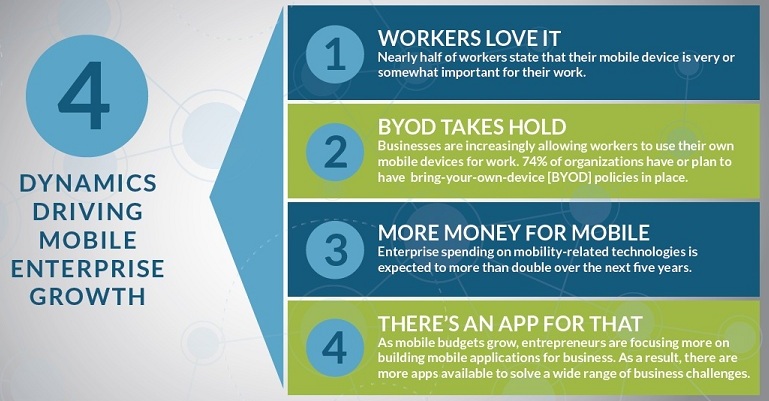
A recent enterprise mobility survey noted that respondents executing business mobility average two to three times the ROI over surveyed organizations that have not undertaken business mobility initiatives [and only run business apps on desktops or physical devices], according to The Mobile Playbook, 3rd Annual Edition produced by EndUserExperience2Day.
Mobile - A Driving Force in the Digital Workplace
The digital workplace is transforming how IT delivers services to end users, as employees want to access network resources from any device, at any time and any location. Not only is this good for employee morale/satisfaction and productivity, it also gives the business a competitive advantage – responding to market changes, competitive threats, and customer needs – much more efficiently.
However, IT isn't the only group morphing how they manage the complexity of their job – so are the employees that comprise the digital workplace.
Mobile within itself has eliminated traditional working hours and made the workforce, and the enterprise, even more borderless. It has increased productivity of employees, while also, in some cases created an "always on" lifestyle. In other words, mobile has left employees to their own devices (pun intended!).
A global survey of CIOs conducted by Gartner Inc. predicts that 38% of companies will stop providing devices to workers by 2016. That's this year! And, by 2017, half of employers will require employees to provide their own devices – otherwise known as "Bring Your Own Device" (BYOD).

Key Findings - What's Inside The 2016 Mobile Playbook
EndUserExperience2Day publishes an annual Mobile Playbook to serve as an educational resource that encapsulates real-world mobile trends, insights and use cases, including exclusive viewpoints from industry experts that enterprises need to strategize, plan and optimize their enterprise mobility initiatives. The 2016 The Mobile Playbook compiles data from more than 40 industry reports with a mix of original content and never-before published insights from VDC Research, Intellyx and ESG.
This year's Mobile Playbook offers several key findings to help enterprises devise and evolve their workforce mobility strategies. Some notable insights include:
■ Mobile Growth & Adoption: By 2017, 100% of the line of business (LOB) apps used in customer-facing roles and 75% of LOB apps used in internally-facing roles will be built for mobile-first consumption.
■ Digital Transformation: By 2017, over 50% of IT spending will be earmarked for new technologies like mobile, cloud and big data.
■ Omni-channel Experience: Today 84% of CIOs in customer-centric companies are focused on improving the mobile customer experience.
■ Mobile Challenges: By the end of 2017, market demand for mobile app development services will grow at least 5X faster than internal IT organizations' capacity to deliver them.
■ Why Enterprise Mobility Matters: A recent enterprise mobility survey noted those respondents, "executing business mobility average two to three times the ROI over surveyed organizations that have not undertaken business mobility initiatives [and only run business apps on desktops or physical devices]."
Donna Parent is Vice President, Marketing at Aternity.
